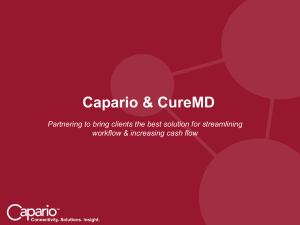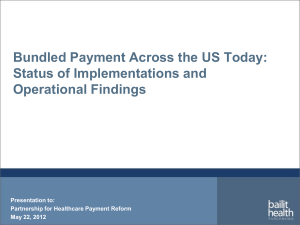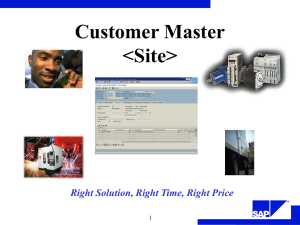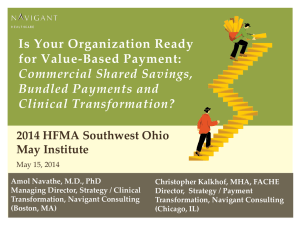Session 1 Objectives
advertisement
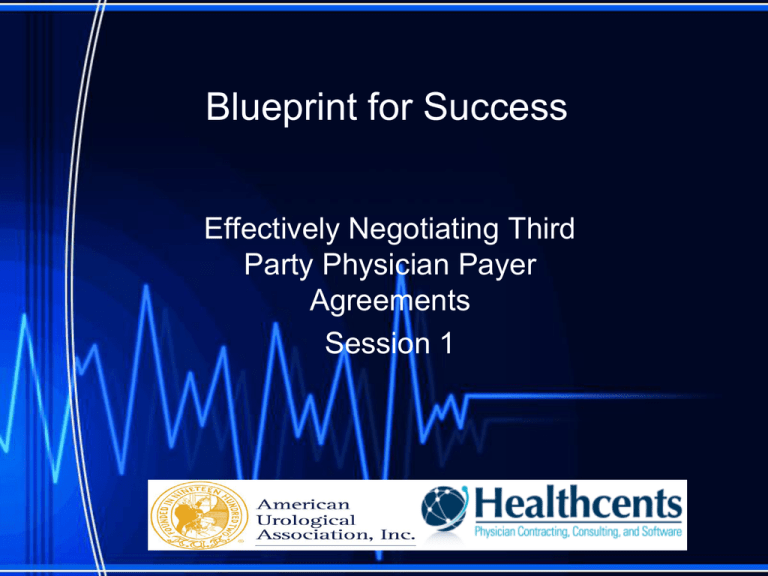
Blueprint for Success Effectively Negotiating Third Party Physician Payer Agreements Session 1 Introductions & Company Overview • Largest national payer contracting corporation , founded in 1994 • Core Businesses, three major products / services: – – – Services: Managed Care Contracting: Enabling physicians, hospitals, ASC’s and ancillary providers to obtain more profitable contracts with health insurance companies (HMO, PPO, ACO and Workers Compensation) • Both analytics and complete soup to nuts end to end negotiations Education: Managed Care Contracting Training and Education for providers and insurers (Tulane, AUA, Alere, AAOE, ASCA and more…) Products and Software Solutions: RevolutionSoftware web / cloud service for optimizing revenue in contracts RevolutionSoftware Claims Analyzer Solution (New) Real time analysis and comparison of claims to contracted rates • On Demand, Internet and Intranet Based Business Model • “Blue Print for Success” Payer Contracting class in partnership with the AUA and Tulane University • 50 Active clients, 1000’s served • Reference accounts, many published at our web site: www.healthcents.com/html/testimonials.html 2 Leadership Team • Ms. Susan Charkin, President – – – – – – – • Mr. Steve Selbst, CEO – – – – – – • The Nationwide Expert in Payer Contracting and Strategy, well known President of Healthcents since 1994 15+ years of Senior Contracting Positions for payers and providers (Healthnet, BCBS, Aetna, University of California, San Francisco, Maxicare and others) Trustee of Natividad Hospital- largest public hospital in central California, a teaching hospital affiliated with UCSF. Leading Author and National Speaker on Managed Care (Boston University, George Washington University, American Ambulance Association, Specialty Capitation, Beckers ASC EMS Insider and others) Expert in ACO’s, put together key roadmap for AUA, interviewed Dr. Elliott Fisher, Brookings Institute, Blue Cross of CA and an early IPA implementer Undergraduate Degree in Education (UVM) and MPH Degree (USF). Manages Healthcents Operations including contract negotiations Successfully negotiated 4,000+ payer contracts Invented Revolution Softwaretm and designed the product 29+ years as a Software and Business Executive in the Software Business working for IBM Managed 300+ people doing key Multi-site and Multi-company business intelligence software development projects (Put together several key business alliances between major software companies) BS. Degree in Business Admin, Arizona State University, Summa Cum Laude and invited to apply for a Fulbright Scholarship Ms. Regina Vasquez, VP of Account Management – – – – – Leads all of our day to day client and contract management Successfully negotiated 4,000+ payer contracts Led the development of a major Skilled Nursing Facility Network for a Large Payer in California Leader in a local economic development commission and in two large non-profit organizations Very skilled negotiator, analyst and project manager, proven track record with references, has made 15%-25% ROI for all of our clients, large and small, est. >$20M in the last five years 3 Session 1 Objectives (Contracting Process Overview) • History of Managed Care • Is contracting worth the effort, why? • Critical Success Factors: Analysis (Quadrant Analysis, Value Based Contracting, Data Analytics) Winning Solutions for maximizing payer contracts Payer Contracting Process Understanding and matching provider’s and payer’s objectives Handling potential “Landmines” , including what to do when a payer will not negotiate Contract Language “Cover Your Contracts” How to sell your practice to payers and to employer groups • Wrap up, Q and A and Quiz 4 Session 2 Objectives (Data Analytics) 1. Perform a benchmarking analysis of payer fee schedules using RevolutionSoftware™ to set fee schedule proposals 2. Identify and define patterns in reimbursement to use in an overall negotiation strategy 3. Analyze and benchmark billed charges against an established minimum percentage of Medicare reimbursement to avoid being paid less than any contract rate and to maximize your cash based business 4. Compare any two of your payer fee schedules on a “normalized code” and volume base to benchmark against each other. 5. Learn and use a practical technique for comparing claims’ payments to contracted rates and assess whether or not you are being “under reimbursed” 6. Objectively assess in network versus out of network reimbursement 5 Session 3 Objectives (SWOT and Contracts Negotiations process) By the end of Session 3 participants will be able to: • Perform a SWOT analysis of your practice to identify strengths, weaknesses, opportunities and threats to your practice in your market with each payer • Apply findings of SWOT and prepare persuasive payer proposal letter that highlights their strengths and opportunities to bring added value to the payer network • Conduct contract negotiations How to handle various payer responses Learn how to handle payer objections and shut downs • Handle escalations and other options 6 Session 4 Objectives (Language, ACO’s, Capitation, 10 Best Practices) • Finish contracts’ negotiations process Language Review Monitor Claims and remember to renegotiate (Best Practice 10) • ACOs and Capitation • Bringing it all together with the 10 Best Practices, review of: How to evaluate a managed care fee proposal Preparing a SWOT analysis to identify opportunities and threats to a practice’s reimbursements Conducting a managed care proposal reimbursement analysis used for benchmarking, pattern identification and business modeling o Evaluate in-network vs. out-of-network options and maximize your billed charges to uniform, customary & reasonable (UCR) levels. Techniques for negotiating “win- win” agreements with managed care companies Simple technique for monitoring claims payments and comparing to your contracted rates to insure that you are not underpaid 7 8 Session 1, “Overview” Agenda: • History of Managed Care • Is contracting worth the effort? • Critical Success Factors: Analysis (Quadrant Analysis, Value Based Contracting, Data Analytics) Winning Solutions for maximizing payer contracts Payer Contracting Process Understanding and matching provider’s and payer’s objectives Handling potential “Landmines” , including what to do when a payer will not negotiate Contract Language “Cover Your Contracts” How to sell your practice to payers and to employer groups • 9 Your one stop shop for all class materials For your convenience, we have established a class web page: www.healthcents.com/aua that contains links to: • Questions and Answers from class participants • Pre-requisite viewing and reading materials • Homework assignments and instructions • Charts presented in class The class web page content will be updated at least one business day before each session to give you time to review materials and to do your homework and preparation work. Overall Objective – Lay a solid foundation for Managed Care Basics to enable your practice to make more revenue 10 History of Managed Care & Third Party Payers 1970s – First serious look at healthcare reform: • Nixon Administration introduced HMOs HMO act of 1973 Main informant was Dr. Paul Ellwood $375 million in federal funds Preempted state laws banning prepaid plans FFS (Fee for Service) had to be changed to achieve positive reform. 1980s – Current: • Continued growth in managed care plans as way to control cost to employers/consumers. • States using managed care models to control cost of Medicaid. Trend continues to be increased enrollment in managed care plans. 11 Is contracting worth the effort? Pros – Potential to increase volume and therefore increase overall revenue – Administratively higher patient satisfaction – Administratively potentially fewer claims appeal issues and less direct collection from patients – Access to more lines of payer’s business and covered lives Cons – Lower reimbursements than out of network – no ability to balance bill • Assumes low patient attrition, and low volume loss – Maintenance fee schedule adjustments – Potentially restrictions on covered services depending on patient’s plan – Multi-year contracts with no opt out if unsatisfied with outcome 12 Critical Success Factors AnalySis SolUtions ProCess ObjeCtives Avoid PotEntial Landmines ContractS’ Language (CYC) Sales Before you negotiate, do your homework! 13 Analysis • Quadrant Analysis, how much do you ask for? • Value Based Contracting • Where does your practice revenue come from? – FFS Rate by CPT x Encounters = Revenue – Bundled Payment – Episode Treatment Groups – Self-performed ancillary services – Capitation • The 20/80 Rule – Identify the top 20 percent of codes that drive 80 percent of your practice’s revenue. – Use the same codes for each payer fee schedule for comparative purposes 14 Healthcents Quadrant Payer Analysis Pay High Conservative 15%-25% 5%-15% Ultra Aggressive Aggressive 35%-45%+ Pay Low Ultra-Conservative Open to Negotiate 25%-35% Not open to negotiate 15 Value Based Contracting Example Efficiency (2% if >70 points) Generic Drug Utilization >90%: 75 pts 88 - 89%: 60 pts 86 - 87%: 45 pts Preferred Drug Utilization >90%: 25 pts. 88 - 89%: 20 pts 86 - 87%: 15 pts Qualitative (2% if >70 points) Follows Best Practices Guidelines 50 pts Active E-Prescriber: 25 pts Quantitative (1% if >70 points) In network referrals only >2.5: 75 pts 2.25 - 2.49: 60 pts 2.0 - 2.24: 45 pts Patient Satisfaction 3 stars: 25 pts 2 stars: 20 pts 16 What Is a Capitation-Based Payment? • Capitation-a payment method for health care services. • Capitation based payment is when the physician, hospital, or other health care provider is paid a contracted rate for each member assigned, referred to as "per-member-permonth" rate, regardless of the number or nature of services provided. • The contractual rates are usually adjusted for age, gender, illness, and regional differences. • More to come in sessions 3 and 4… Mosby's Medical Dictionary, 8th edition. © 2009, Elsevier. Analysis – Benchmarking Before & After 18 Analysis – Reimbursement Summary Source: HealthcentsRevolution ™ 19 When the payer will not negotiate Source: HealthcentsRevolution ™ 20 Analysis – Are your billed charges high enough? Source: HealthcentsRevolution ™ 21 Analysis– Are you getting paid correctly? Source: HealthcentsRevolution ™ 22 Question? If we have two CPT codes, 27130 which is paid @80% of Medicare, including patient co-payment, by the payer, at $1600/service and code 99213 which is paid @90% of Medicare, including patient co-payment, by the payer, at $60/service and 27130 is performed 100 times a year and 99213 is performed 1000 times a year and I can get a 20% increase on one or the other, but not both codes, which code should I accept the increase on to increase my revenue the most? a) Code 99213 b) Code 27130 23 Saleable Solutions– Payers have problems you can solve • Practice size and revenue, recent merger – Consult legal counsel about ramifications • Financial- Do you have enough $$/patients to justify a contract? – In office vs. facility based procedures • Geographic- Are you the only game in town? How close is the nearest Physician Practice that practice same specialties? • Demographics- Does your practice include large employer groups in the area? • Unique Quality/Services- What are you doing that no one else is doing? 24 Saleable Solutions – Payers have problems (Continued) • Logistics- Where do you hold privileges? Are you currently out of network and turning away patients? • Economics- What cost efficiencies does your group offer? – Electronic Health Records – Generic Drugs – E-prescribing – In-network referrals to ancillary services – Collaboration with PCP groups – ASC utilization • Quality- patient satisfaction survey, PQRI participation 25 Contracts Negotiations Process • Data Analysis • Proposal Letter • Make Initial Contact with Payer • Analyze Counter • Negotiate until agreement is reached • Escalate to Sr. Level Manager • Consider Out of Network Option • Monitor Claims • Re-Negotiate Phase 1: Phase 2: Phase 2: Phase 3: Prepare Negotiate Continue to Negotiate Monitor / Re-negotiate Negotiations Completed 26 Objectives • Provider – Optimize reimbursement – Enhanced reimbursement for high-cost, specialized services – Increase capacity for new lines of business and revenue streams • Payer – Maximize revenue and profit – Minimize fees paid – Market competitive – Cost Efficiency – Quality – Increased capacity for new lines of business and revenue streams Performance based Contracting Office Based Procedures Reduction of length of hospital stay Preventative care Leverage market position (Provider) 27 Avoid Potential Landmines • There are things that payers would rather you do not know or discover: – Statewide fee schedules – several payers are moving to statewide or locally regional fee schedules that pay uniform fees to all providers. Consider the following to combat that policy: • PPO Only • Office Based Surgical Procedures • Carve outs • Performance Based Contracts – In-house, ancillary services • Make sure you can get reimbursed for all of the services you provide. Some payers are sole sourcing lab/path to large chain vendors. Even so, there are usually some services that will still be reimbursed in the office setting. 28 Avoid Potential Landmines • Mergers/Consolidation… – Hospitals and physician groups are not the only ones merging! Aetna recently purchased Coventry, Cigna purchased GW several years ago. 10/1/11 is the consolidation date and GW fee schedules are going to be converted to Cigna fee schedules. UHC bought options to Healthnet of the Northeast contracts. As of 3/31/11, Healthnet has no active contracts in the Northeastern U.S. All of the Healthnet covered lives were offered as UHC products on renewal. Multiplan purchased Viant (Beechstreet) last year. Beechstreet may be phased out over time and replace with Multiplan product lines. Practices need to be alert to this activity and get ahead of the negotiation curve, so that when old plans / companies phase out the transition is seamless and reimbursement is not negatively affected. 29 Potential Landmines • Benchmark your payer agreements against each other. Identify service categories where you can optimize your fee schedule through negotiation of specific service groups (E&M, Surgical Urinary, etc.) • Don’t take the first “no” you hear. Payer organizations are usually several layers deep. The front line negotiator may not have ultimate decision making authority and it is worth requesting a meeting with senior management if you are not getting anywhere with the initial representative. 30 When the payer will not negotiate • The decision to go out of network: – How much does that payer account for in the practice’s total book of business? – Will the payer write checks to the patient rather than the practice? – How many of your patients will you lose if you have to collect directly from the patient rather than billing the payer? – How much additional administrative cost will you incur on pre-authorizations and collections? – How much of an increase would you need to make it worth your while to stay? 31 Contracts’ Language CYC (Cover Your Contracts) • We recommend having all agreements reviewed by legal counsel. But here are a few terms to watch for: • • • • • • Term, Termination w/o Cause & Termination for Breach General / Fee schedule Amendment - you want minimal notification requirements for termination that are untethered to the anniversary date of your agreement, or annual. Timely filing– make sure you have enough time to process secondary insurance claims. Timely payment– make sure that you receive payment within 30 days of receipt of a clean claim. “Lesser of Billed Charges” Language. Make sure your chargemaster is set high enough to avoid this. Notification requirements – make sure the payer has to provide sufficient notification for changes, administrative amendments to the contract, including fee schedule maintenance changes. Retrospective review Language: make sure that there is a reasonable time, <90 days, if possible, for retrospective claims 32 reviews for the payer to collect from you. “CYC” continued… • Silent PPO’s • No “favored nation” language (i.e., you get a decrease if your best contract is lower than this payer’s overall contracted rate • Check rates across product lines and map the product lines to your patients Multiple PPOs, HMO, Medicare Advantage etc. • Carved out codes • Calibration to current year Medicare %, watch out! • Excluded services • Multiple procedures and bundling 33 Sales • Accountable Care: If you have significantly robust IT capacity and/or are active in a virtual network of coordinated care providers, you may want to float the idea of participation Consult Legal Counsel before signing on 34 Sales Employer Groups (Who are a part of a payer’s plan): • Make direct contact with the HR department to see if you can reach out to employees. Be creative, e.g., offer to contribute health news to the company newsletter/bulletin. Offer to attend / help with health fairs or workplace wellness programs / policies Employer Groups (Who are self insured, “ASOs”) Reach out to these large groups for participation 35 Critical Success Factors AnalySis SolUtions ProCess ObjeCtives Avoid PotEntial Landmines ContractS’ Language (CYC) Sales Before you negotiate, do your homework! 36 Summary • We covered how to determine which payers to negotiate with, if your practice will benefit from engaging in negotiation with the payer and tips on how to navigate the process to successfully complete a negotiation. • Thank you for inviting us to be your tour guide and we wish you Succe$$. 37 Questions & Answers Please submit your questions to PRACTICE MANAGEMENT using the chat window. Access the chat window by hovering your cursor over the green menu tab at the top middle of your screen. When it appears click on the chat icon in the menu bar at the top middle of your screen. 38 Homework View RevolutionSoftware™ Demonstration. AND enroll to get your no charge four month license. For instructions on how to access and view the demo and enroll, please visit RevolutionCentral at: www.healthcents.com/html/revcentral.html 39 If you have questions • RevolutionSoftware Registration and Questions™ • Regina Vasquez, Sr. VP of Accounts – Healthcents, Inc. • Tel: (719) 243-3845 • rvasquez@healthcents.com • Class Help: support@healthcents.com or 1-800-497-4970 • Healthcents Inc. Headquarters: • Susan Charkin, President, Steve Selbst, CEO, Healthcents, Inc. • Tel: (800) 497-4970 • Ms. Inez Wondeh, inez@healthcents.com, 707-246-7243 • charkin@healthcents.com or selbst@healthcents.com • www.healthcents.com 40

